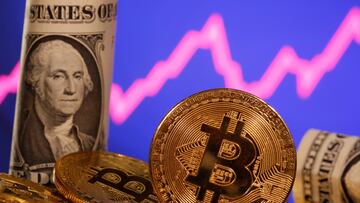What are the reasons for bitcoin’s rise in the last few days?
Cryptocurrencies are in the doldrums after being battered by a tempest of anxiety over the current economic situation, but some think they’ve bottomed out.

Volatility in the price of cryptocurrencies has taken investors on a rollercoaster ride over the past year. But with supposedly stablecoins becoming unpegged from the dollar in May, Terra Luna basically became worthless, the digital coin market went into freefall.
The oldest and biggest of the digital coins, Bitcoin, is now hovering around $30,000 less than a third of its value in March. It has lost over half its value since it reached its peak in November last year, but some investors are venturing back into the market, though cautiously.
Also see:
Investors betting Bitcoin has bottomed out
Bitcoin, along with other more established cryptocurrencies, were thought to be a hedge against volatility in other markets. However, that did not prove the case as the major indexes on Wall Street reacted to the economic headwinds from the Federal Reserve raising interest rates, rising inflation and global economic concerns. Cryptocurrencies plunged in tandem with Wall Street almost tracking parallel with drops in the Nasdaq.
After dipping below $27,000, Bitcoin has been moving above and below $30,000 for about a month. Some investors seem to think the digital coin has bottomed out and are now wading back into what could still be turbulent waters, not fit for the faint of heart. They are taking cautious steps investing in bitcoin futures exchange-traded funds (ETFs) which promise greater liquidity and security.
These represent a small portion of the market but are popular among both institutional and retail players. After suffering a weekly average outflow of $49.6 million in April, the tide turned last month and ETFs are experiencing a $66.5 million weekly average inflow, according to data provider CryptoCompare.
Billionaires Remain Wary Of Bitcoin—But They’re Buying Crypto At A Higher Rate Than The Average Investor, Forbes Survey Finds https://t.co/16YDjamNMt pic.twitter.com/XKPhXqdRgu
— Forbes (@Forbes) June 8, 2022
Digital assets market awaiting new regulations
Uncertainty about digital currencies and assets has also been based on how regulators will treat the niche market which has failed to gain mainstream adoption as some had hoped. However, new proposed legislation in Congress could help and has been lauded by the crypto industry.
The framework for new rules, that still need to be hammered out, were unveiled by Senators Cynthia Lummis, Republican from Wyoming, and Kirsten Gillibrand, Democrat from New York. The Digital Commodity Exchange Act is not expected to be passed any time soon, “absent a crisis,” with midterm elections looming.
But lobbyists for the crypto industry see it as a great start, taking the conversation to the next level in the debate on how to regulate digital assets. Albeit they see areas for improvement.
And yet I keep hearing from crypto boosters insisting that it will reduce transaction costs. Also that it's very new, so the world doesn't get it yet — even though Bitcoin is 13 years old https://t.co/23HkmXK8WI
— Paul Krugman (@paulkrugman) June 8, 2022
What is in the Digital Commodity Exchange Act
Features that they approve of include not taxing cryptocurrency transactions that are less than $200. This could stimulate the use of digital coins for everyday purchases and ordinary payments.
Another would require stablecoins to hold a 100 percent reserve of an fiat asset to guarantee that they can be redeemed by holders for the equivalent dollar value at any time. Additionally, issuers would be required to present detailed disclosures of their reserves and no algorithmic stablecoins like TerraUSD would be able to exist.
Related stories
The legislation would hand the bulk of digital asset oversight to the Commodity Futures Trading Commission (CFTC). Not everyone is happy about this feeling that it will likely result in crypto being largely unregulated.
“The industry wants the CFTC as its regulator because it is the smallest financial regulator with the smallest budget,” said Dennis Kelleher, chief executive of nonprofit consumer advocacy group Better Markets. “Giving the CFTC jurisdiction over crypto is like New York City outsourcing crime fighting to a small-town police force.”
